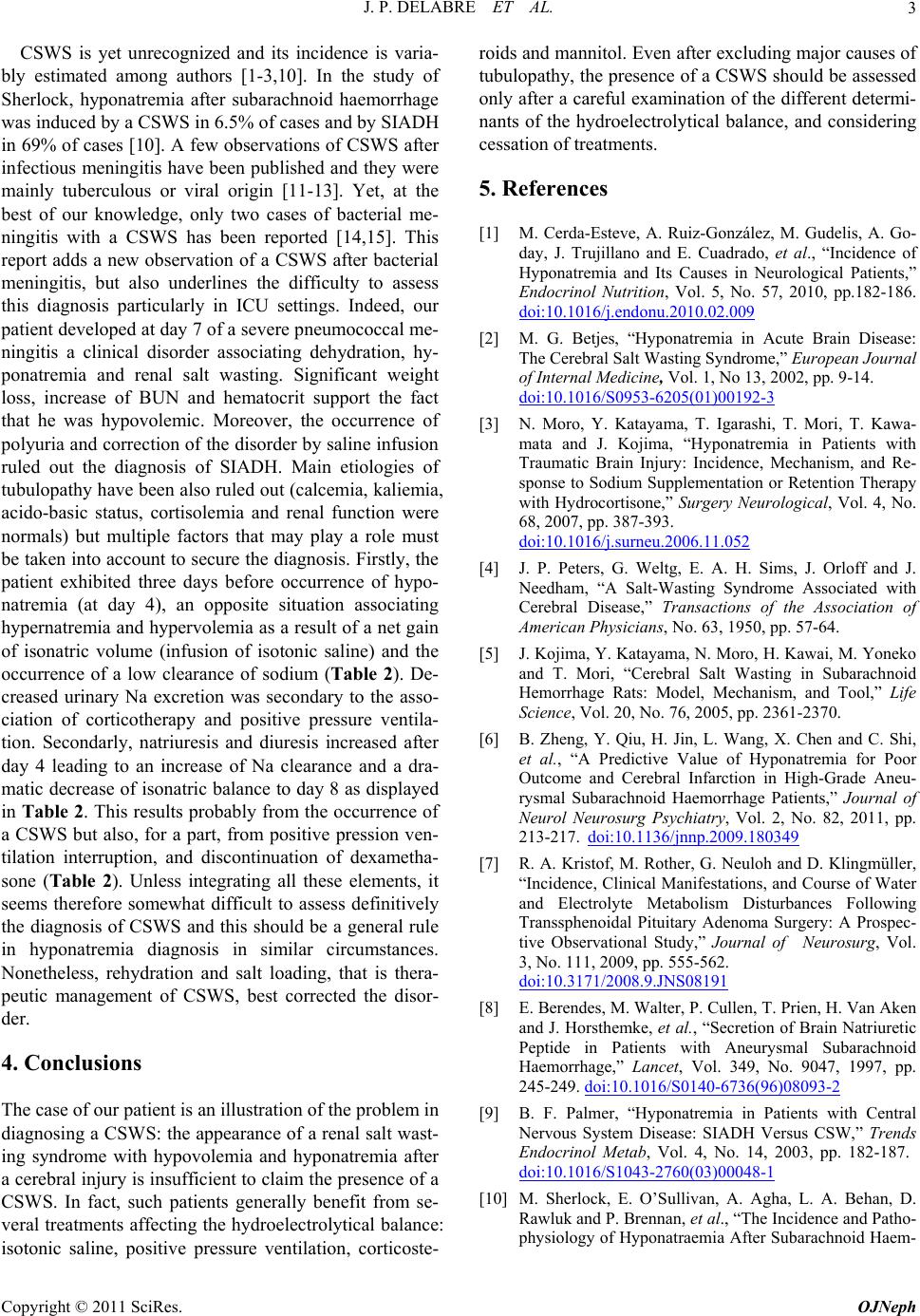
J. P. DELABRE ET AL.
Copyright © 2011 SciRes. OJNeph
3
CSWS is yet unrecognized and its incidence is varia-
bly estimated among authors [1-3,10]. In the study of
Sherlock, hyponatremia after subarachnoid haemorrhage
was induced by a CSWS in 6.5% of cases and by SIADH
in 69% of cases [10]. A few observations of CSWS after
infectious meningitis have been published and they were
mainly tuberculous or viral origin [11-13]. Yet, at the
best of our knowledge, only two cases of bacterial me-
ningitis with a CSWS has been reported [14,15]. This
report adds a new observation of a CSWS after bacterial
meningitis, but also underlines the difficulty to assess
this diagnosis particularly in ICU settings. Indeed, our
patient developed at day 7 of a severe pneumococcal me-
ningitis a clinical disorder associating dehydration, hy-
ponatremia and renal salt wasting. Significant weight
loss, increase of BUN and hematocrit support the fact
that he was hypovolemic. Moreover, the occurrence of
polyuria and correction of the disorder by saline infusion
ruled out the diagnosis of SIADH. Main etiologies of
tubulopathy have been also ruled out (calcemia, kaliemia,
acido-basic status, cortisolemia and renal function were
normals) but multiple factors that may play a role must
be taken into acco unt to secure the diagnosis. Firstly, the
patient exhibited three days before occurrence of hypo-
natremia (at day 4), an opposite situation associating
hypernatremia and hypervolemia as a result of a net gain
of isonatric volume (infusion of isotonic saline) and the
occurrence of a low clearance of sodium (Table 2). De-
creased urinary Na excretion was secondary to the asso-
ciation of corticotherapy and positive pressure ventila-
tion. Secondarly, natriuresis and diuresis increased after
day 4 leading to an increase of Na clearance and a dra-
matic decrease of isonatric balance to day 8 as displayed
in Table 2. This results probably from the occurrence of
a CSWS but also, for a part, from positive pression ven-
tilation interruption, and discontinuation of dexametha-
sone (Table 2). Unless integrating all these elements, it
seems therefore somewhat difficult to assess definitively
the diagnosis of CSWS and this should be a general rule
in hyponatremia diagnosis in similar circumstances.
Nonetheless, rehydration and salt loading, that is thera-
peutic management of CSWS, best corrected the disor-
der.
4. Conclusions
The case of our patient is an illustration of the problem in
diagnosing a CSWS: the appearance of a renal salt wast-
ing syndrome with hypovolemia and hyponatremia after
a cerebral injury is insufficient to claim the presence of a
CSWS. In fact, such patients generally benefit from se-
veral treatments affecting the hydroelectrolytical balance:
isotonic saline, positive pressure ventilation, corticoste-
roid s and man nitol. Even af ter ex cluding major cause s of
tubulopath y, the presence of a CSWS should be assessed
only afte r a careful examinati on of the different determi-
nants of the hydroelectrolytical balance, and considering
cessation of treatments.
5. References
[1] M. Cerda-Esteve, A. Ruiz-González, M. Gudelis, A. Go-
day, J. Trujillano and E. Cuadrado, et al., “Incidence of
Hyponatremia and Its Causes in Neurological Patients,”
Endocrinol Nutrition, Vol. 5, No. 57, 2010, pp.182-186.
doi:10.1016/j.endonu.2010.02.009
[2] M. G. Betjes, “Hyponatremia in Acute Brain Disease:
The Cerebral Salt Wasting Syndrome,” European Journal
of Internal Medicine, Vol. 1, No 13, 2002, pp. 9-14.
doi:10.1016/S0953-6205(01)00192-3
[3] N. Moro, Y. Katayama, T. Igarashi, T. Mori, T. Kawa-
mata and J. Kojima, “Hyponatremia in Patients with
Traumatic Brain Injury: Incidence, Mechanism, and Re-
sponse to Sodium Supplementation or Retention Therapy
with Hydrocortisone,” Surgery Neurological, Vol. 4, No.
68, 2007, pp. 387-393.
doi:10.1016/j.surneu.2006.11.052
[4] J. P. Peters, G. Weltg, E. A. H. Sims, J. Orloff and J.
Needham, “A Salt-Wasting Syndrome Associated with
Cerebral Disease,” Transactions of the Association of
American Physicians, No. 63, 1950, pp. 57-64.
[5] J. Kojima, Y. Katayama, N. Moro, H. Kawai, M. Yoneko
and T. Mori, “Cerebral Salt Wasting in Subarachnoid
Hemorrhage Rats: Model, Mechanism, and Tool,” Life
Science, Vol. 20, No. 76, 2005, pp. 2361-2370.
[6] B. Zheng, Y. Qiu, H. Jin, L. Wang, X. Chen and C. Shi,
et al., “A Predictive Value of Hyponatremia for Poor
Outcome and Cerebral Infarction in High-Grade Aneu-
rysmal Subarachnoid Haemorrhage Patients,” Journal of
Neurol Neurosurg Psychiatry, Vol. 2, No. 82, 2011, pp.
213-217. doi:10.1136/jnnp.2009.180349
[7] R. A. Kristof, M. Rother, G. Neuloh and D. Klingmüller,
“Incidence, Clinical Manifestations, and Course of Water
and Electrolyte Metabolism Disturbances Following
Transsphenoidal Pituitary Adenoma Surgery: A Prospec-
tive Observational Study,” Journal of Neurosurg, Vol.
3, No. 111, 2009, pp. 555-562.
doi:10.3171/2008.9.JNS08191
[8] E. Berendes, M. Walter, P. Cullen, T. Prien, H. Van Aken
and J. Horsthemke, et al., “Secretion of Brain Natriuretic
Peptide in Patients with Aneurysmal Subarachnoid
Haemorrhage,” Lancet, Vol. 349, No. 9047, 1997, pp.
245-249. doi:10.1016/S0140-6736(96)08093-2
[9] B. F. Palmer, “Hyponatremia in Patients with Central
Nervous System Disease: SIADH Versus CSW,” Trends
Endocrinol Metab, Vol. 4, No. 14, 2003, pp. 182-187.
doi:10.1016/S1043-2760(03)00048-1
[10] M. Sherlock, E. O’Sullivan, A. Agha, L. A. Behan, D.
Rawluk and P. Brennan, et al., “The Incidence and Patho-
physiology of Hyponatraemia After Subarachnoid Haem-